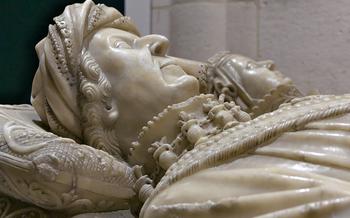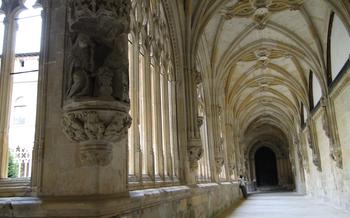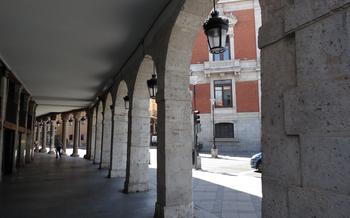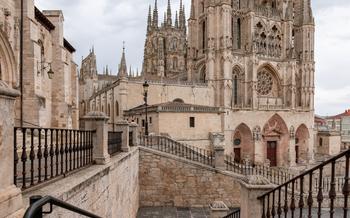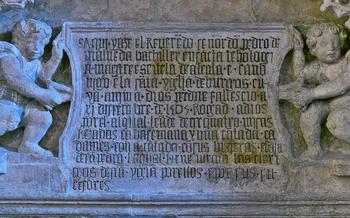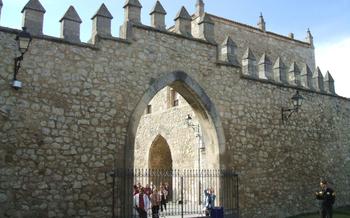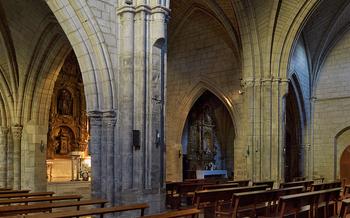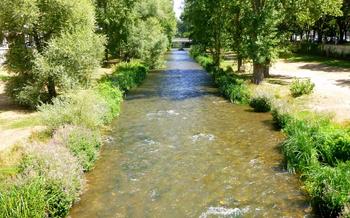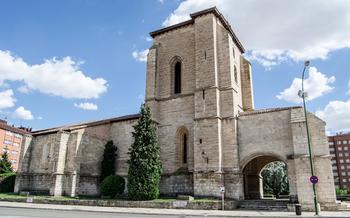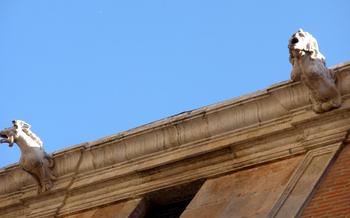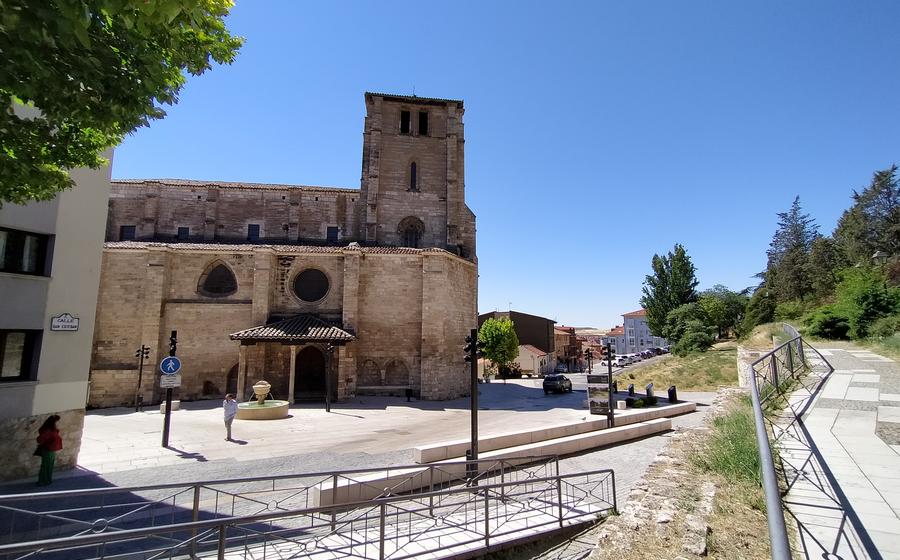
Iglesia de San Esteban
- Iglesia de San Esteban: A Monumental Treasure in Burgos
- San Esteban's Majestic Portal: A Gothic Masterpiece
- The Captivating Altarpiece: A Renaissance Masterpiece
- Exploring the Cloister: A Serene Haven
- The Museum: Unveiling Hidden Treasures
- Guided Tours: Enriching Your Experience
- Attending a Mass or Service: A Spiritual Encounter
- Photography Tips: Capturing the Beauty
- Accessibility and Facilities: Planning Your Visit
- Incorporating the Visit into Your Burgos Itinerary
- Historical Context: The Story Behind the Church
- Restoration Efforts: Preserving the Legacy
- Local Insights: Engaging with the Community
- Hidden Gems: Discovering Lesser-Known Features
- Insider Tip: Enhancing Your Experience
Iglesia de San Esteban: A Monumental Treasure in Burgos
The Iglesia de San Esteban, a testament to the grandeur of Gothic and Renaissance architecture, stands as one of Burgos's most magnificent landmarks. Built in the 13th century and completed in the 16th century, this edifice showcases a harmonious blend of architectural styles, reflecting the city's rich history and artistic heritage.
Conveniently located in the heart of the city, just a short walk from the iconic Burgos Cathedral, the Iglesia de San Esteban beckons visitors with its imposing presence. Its exterior boasts intricate carvings, delicate pinnacles, and a stunning rose window, hinting at the artistic wonders that await within.
Step inside this sacred space and marvel at the soaring vaults, graceful arches, and an abundance of natural light filtering through the stained-glass windows. Admire the intricate details adorning every corner, from the beautifully sculpted capitals to the delicate tracery of the ribbed vaults.
San Esteban's Majestic Portal: A Gothic Masterpiece
The Iglesia de San Esteban proudly showcases an awe-inspiring Gothic portal, a true testament to the artistic brilliance of the era. As you approach the entrance, intricate carvings and sculptures adorn the grand doorway, captivating your gaze. The tympanum, the semi-circular space above the lintel, narrates biblical stories through its exquisite reliefs. Angels, saints, and biblical figures come to life in stone, each detail meticulously crafted to convey a profound message. The portal's design pays homage to the Gothic style's emphasis on verticality, drawing your eyes upwards towards the heavens.
The symbolism embedded within the portal's carvings is a testament to the church's deep religious significance. Every element, from the smallest detail to the overall composition, holds a symbolic meaning. The central figure of Christ dominates the tympanum, surrounded by scenes depicting the Last Judgment, the Resurrection, and the Ascension. These biblical narratives serve as a reminder of the church's central teachings and the promise of salvation for those who follow the path of righteousness.
The artistic techniques employed in the portal's creation are a marvel of Gothic craftsmanship. The sculptures exhibit a remarkable level of naturalism and realism, capturing the emotions and expressions of the figures with astonishing accuracy. The play of light and shadow enhances the three-dimensional effect, creating a sense of depth and movement. The harmonious blend of biblical storytelling, intricate symbolism, and superb craftsmanship makes San Esteban's portal a masterpiece of Gothic art, a testament to the enduring legacy of this architectural style.
The Captivating Altarpiece: A Renaissance Masterpiece
The captivating altarpiece of the Iglesia de San Esteban stands as a testament to the artistic brilliance of the Renaissance era. Commissioned by Bishop Juan Rodríguez de Fonseca in 1508, this magnificent work of art took over a decade to complete, with the participation of renowned sculptors and carvers such as Gil de Siloé and Diego de Siloé.
The altarpiece is a masterpiece of polychrome sculpture, intricately carved with scenes from the life of Christ, the Virgin Mary, and various saints. The central panel depicts the crucifixion, flanked by panels illustrating the Annunciation, the Nativity, and the Resurrection. The intricate details and lifelike expressions of the figures bring the biblical narratives to life, inviting viewers to contemplate the profound significance of these events.
The altarpiece's design is a testament to the Renaissance emphasis on balance and symmetry. The harmonious arrangement of the panels creates a sense of unity and coherence, while the use of perspective and depth adds a touch of realism to the scenes. The altarpiece's vibrant colors and gold leaf further enhance its grandeur, creating a striking visual spectacle that leaves visitors in awe.
Exploring the Cloister: A Serene Haven
Step into the tranquil embrace of the cloister, a serene sanctuary adorned with intricate Gothic arches and delicate tracery. Constructed during the 16th century, the cloister exudes an aura of peace and spirituality, inviting you to pause and reflect.
Admire the exquisite carvings that adorn the cloister's columns and capitals, each one a testament to the skill and artistry of medieval craftsmen. Graceful figures and biblical scenes unfold before your eyes, narrating stories of faith and devotion.
As you wander through the cloister, notice the serene atmosphere that envelops you. The gentle sound of footsteps echoes through the arcaded walkways, creating a symphony of tranquility. Let the weight of the world melt away as you immerse yourself in the cloister's soothing embrace.
In the center of the cloister, a tranquil garden flourishes, adding a touch of nature's beauty to this sacred space. Take a moment to sit on one of the stone benches and savor the serenity of your surroundings, allowing your mind to find solace and renewal.
The Museum: Unveiling Hidden Treasures
The museum at the Iglesia de San Esteban houses a captivating collection of religious artifacts, relics, and historical objects that provide a deeper insight into the church's rich history. Visitors can marvel at intricate gold and silverwork, elaborately decorated vestments, and rare manuscripts that showcase the artistry and craftsmanship of past centuries.
Among the notable exhibits are ancient relics associated with the lives of saints and martyrs, offering a tangible connection to the church's spiritual heritage. Visitors can also admire a collection of medieval sculptures, paintings, and liturgical objects that provide a glimpse into the artistic and devotional practices of the time.
Interactive displays and multimedia presentations enhance the museum experience, bringing to life the stories and events that have shaped the church's history. These engaging exhibits allow visitors to explore the church's architectural features, significant events, and the role it has played in the community over the centuries.
Guided Tours: Enriching Your Experience
Enhance your visit to the Iglesia de San Esteban by joining a guided tour, available in various languages. Thematic tours focus on specific aspects, such as the church's history, architecture, or art, providing a deeper understanding and appreciation. Tours typically last around an hour and cost a nominal fee. Advance booking is recommended to secure your spot, especially during peak tourist season. Guided tours offer an enriching experience, allowing you to delve into the intricacies of this Gothic masterpiece and gain insights from knowledgeable guides.
Attending a Mass or Service: A Spiritual Encounter
Attending a mass or service at the Iglesia de San Esteban is an opportunity to immerse yourself in the spiritual essence of this sacred space. Masses are held regularly, providing visitors with a chance to witness the devotion and spirituality of the local community. Local customs and traditions are observed during these services, enriching the experience for visitors. Appropriate attire and a respectful demeanor are expected to maintain the sanctity of the religious space. Participating in a mass or service offers a deeper connection to the history and cultural significance of the church, allowing visitors to transcend the boundaries of mere sightseeing and experience a profound spiritual encounter.
Photography Tips: Capturing the Beauty
The Iglesia de San Esteban offers ample opportunities for photography enthusiasts to capture its architectural grandeur and intricate details. To make the most of your photography experience, consider the following tips:
Lighting: For optimal lighting conditions, plan your visit during the golden hours of sunrise or sunset when the warm, diffused light casts a magical glow on the church's facade. If you're visiting during the day, try to avoid harsh midday light, which can create harsh shadows and washed-out colors.
Angles and Vantage Points: Experiment with different angles and vantage points to capture the church's imposing presence. Step back to capture the full grandeur of the exterior, including the bell tower and surrounding buildings. For close-up shots, focus on specific architectural details, such as the intricate carvings on the portal or the delicate tracery of the windows.
Details and Close-ups: Don't forget to zoom in on the intricate details that make the Iglesia de San Esteban so unique. Capture the delicate carvings on the capitals, the expressive faces of the sculptures, and the intricate patterns of the stained-glass windows. These details add depth and character to your photographs.
Respect the Sacred Space: While capturing the beauty of the church, remember that it is an active place of worship. Be respectful of ongoing services or ceremonies and avoid using flash photography, which can be disruptive. Always ask for permission before photographing people, especially during religious services.
Accessibility and Facilities: Planning Your Visit
The Iglesia de San Esteban is dedicated to ensuring that all visitors have a comfortable and enjoyable experience. Accessibility features are in place for visitors with disabilities, allowing them to navigate the church with ease. Restrooms and drinking fountains are conveniently located throughout the premises. For a memorable souvenir, visit the on-site gift shop, which offers a variety of items inspired by the church's history and artwork. Strollers and wheelchairs can be accommodated, making it easy for families with young children or individuals with mobility challenges to explore the church's wonders.
Incorporating the Visit into Your Burgos Itinerary
To fully appreciate the charm of Burgos, consider exploring the city on foot. Begin your journey at the Plaza Mayor, the central square, and take a leisurely stroll along the Calle Mayor, the main shopping street. As you soak in the vibrant atmosphere, make your way to the Iglesia de San Esteban, nestled in the heart of the old town.
Once you've marveled at the church's beauty, continue your exploration of the surrounding area. Discover the imposing Burgos Cathedral, a UNESCO World Heritage site, just a short walk away. Admire its Gothic architecture and climb the bell tower for breathtaking city views.
For a taste of local culture, head to the bustling Mercado de Abastos, a lively indoor market. Browse the colorful stalls, sample regional delicacies, and interact with friendly vendors.
To delve deeper into the city's history, visit the Museo de Burgos, home to a fascinating collection of archaeological and artistic treasures. Learn about the region's rich heritage and admire exhibits that showcase the evolution of Burgos from its ancient origins to the present day.
For a unique perspective, take a guided tour of the city walls. Walk along the ancient ramparts and discover hidden corners that offer stunning panoramic views. As you explore, listen to captivating tales of Burgos's past, when the walls served as a vital defense against invaders.
End your Burgos adventure with a delightful dining experience at one of the city's many traditional restaurants. Sample the local specialty, lechazo asado, a mouthwatering roasted lamb dish, paired with a glass of the region's renowned Ribera del Duero wine.
Historical Context: The Story Behind the Church
The Iglesia de San Esteban has a rich and fascinating history dating back to the Middle Ages. Its construction began in the 13th century under the patronage of King Ferdinand III of Castile, who laid the foundation stone in 122The church was conceived as a symbol of the city's growing power and prestige and was built on the site of a former Romanesque church.
Over the centuries, the church underwent several expansions and modifications, reflecting the evolving architectural styles and tastes of the time. In the 15th century, the magnificent Gothic portal was added, and in the 16th century, the stunning Renaissance altarpiece was installed.
The church played a pivotal role in the religious and social life of Burgos. It served as a place of worship, a center for education, and a refuge for the needy. It also witnessed numerous historical events, including royal weddings, coronations, and religious festivals.
Throughout its history, the church has undergone several renovations and restorations, ensuring its preservation for future generations. Today, the Iglesia de San Esteban stands as a testament to the architectural prowess and spiritual significance of the Middle Ages, attracting visitors from around the world.
Restoration Efforts: Preserving the Legacy
The Iglesia de San Esteban has undergone numerous restoration projects over the centuries, aimed at preserving its architectural integrity and artistic splendor. One of the most significant restorations took place in the 19th century, when the church was in a state of disrepair due to neglect and the passage of time. The project involved extensive repairs to the structure, including the reinforcement of the walls and the restoration of the intricate carvings on the exterior.
In recent years, the church has undergone another round of restoration, focusing on the preservation of the interior. This project included the cleaning and restoration of the altarpiece, as well as the repair of damaged frescoes and murals. The restoration team also worked to improve the lighting system within the church, allowing visitors to better appreciate the beauty of the artwork and architecture.
The ongoing restoration efforts at the Iglesia de San Esteban are a testament to the importance of preserving our cultural heritage. By meticulously restoring the church, we ensure that future generations can continue to marvel at its beauty and learn about its historical significance.
Local Insights: Engaging with the Community
To truly immerse yourself in the history and significance of the Iglesia de San Esteban, take the time to engage with the local community. Seek out conversations with the friendly and knowledgeable guides who can share anecdotes and stories that bring the church's past to life. Learn about the cultural customs and traditions that revolve around the church, such as the annual processions and festivals that celebrate its patron saint. Listen to the local legends and stories that have been passed down through generations, adding a touch of mystery and intrigue to your visit. By connecting with the local community, you'll gain a deeper understanding and appreciation for the Iglesia de San Esteban, making your experience truly unforgettable.
Hidden Gems: Discovering Lesser-Known Features
While the Iglesia de San Esteban is renowned for its grand architecture and iconic features, it also holds hidden gems that reveal its rich history and artistic prowess. One such gem is the intricately carved confessional located in the northern corner of the church. Its elaborate carvings and delicate details often go unnoticed by visitors, making it a true treasure to discover.
Another hidden gem is the "Capilla del Santo Cristo de Burgos," a small chapel tucked away in the cloister. It houses a revered crucifix known as the "Cristo de Burgos," which is believed to date back to the 13th century. The chapel exudes a serene and intimate atmosphere, inviting visitors to reflect on the significance of this sacred object.
For those with a keen eye for detail, the church's exterior holds hidden surprises as well. Look out for the intricate gargoyles perched atop the buttresses, each with unique expressions and designs that add a touch of whimsy to the Gothic facade. These gargoyles were not merely decorative elements but also served a practical purpose, channeling rainwater away from the building.
Discover the beauty of these hidden gems by taking your time to explore every nook and cranny of the Iglesia de San Esteban. These lesser-known features offer a glimpse into the church's fascinating past and the artistry that went into its creation, making your visit even more enriching and memorable.
Insider Tip: Enhancing Your Experience
To fully immerse yourself in the charm of the Iglesia de San Esteban, plan your visit for the golden hour, when the soft hues of dawn or dusk illuminate the intricate carvings and stained glass windows, casting a magical glow upon the entire structure. During this time, the play of light and shadow creates a captivating atmosphere that heightens the sense of awe and wonder. Additionally, keep an eye out for special events or exhibitions that are occasionally held within the church's premises. These events offer a unique opportunity to delve deeper into the history, art, and significance of this architectural masterpiece.
After your visit, take a moment to savor the experience with a refreshing beverage or a delectable snack at one of the charming cafes or restaurants nestled in the vicinity of the church. Indulge in local specialties and delicacies that are deeply rooted in the culinary traditions of Burgos, allowing you to further connect with the city's rich cultural heritage.
